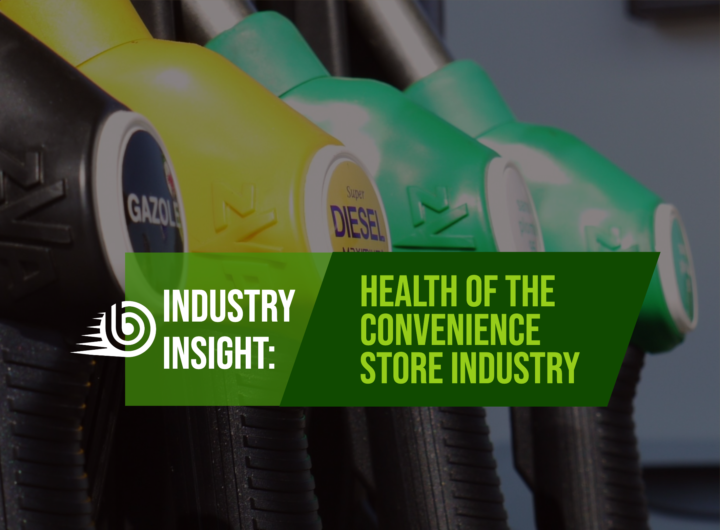As the U.S. economy continues its record economic expansion of more than 10 years, c-store operators look to the future from a position of financial stability as the U.S. convenience store (c-store) industry shows ongoing strength. Motor fuel, which accounts for approximately 70% of c-store Sales and 39% of gross profit dollars, has seen year over year gains in both gallons sold and in fuel pool margin. A same firm sample of 94 companies operating 3,277 stores reveals that for the 12 months ending in May 2019 compared with the 12 months ending in May 2018, fuel gallons sold per fuel location have risen by 1,999 gallons to 135,800 gallons per site with motor fuel pool margins increasing by 2.88 cpg to 24.93 cpg. The combination of improved volumes and margins has boosted fuel gross profits by 14.7%. Total inside sales have increased 4.5% overall with food service sales rising 5.5% and c-store merchandise sales up 4.3%.
Within the c-store merchandise sales category, packaged beverages have been especially strong with year over year sales increases of 6.3%. With slightly lower margins this category’s gross profit has grown by a lesser amount of 5.4%. The cigarette/tobacco category has seen a 3.7% increase in sales at a slightly higher gross profit percentage resulting in a 6.3% growth in gross profit dollars. The growth in this category has been entirely due to the growth of tobacco products, other than cigarettes. Carton movement of cigarettes is down 74 cartons per location per month or 8.6%. The snacks/salty and sweet snack category grew sales by 3.8% with stable margins resulting in a 3.8% gain in gross profit dollars. General merchandise sales have been flat year over year, but margins have improved resulting in a gain of 3.6% in gross profit dollars for this category. The packaged frozen food category which includes ice cream/novelties, ice, and frozen food was down slightly in terms of sales and saw a margin decline of 4.7% (=2 percentage points of margin) resulting in a decline of gross profit dollars of 5.3%. C-store merchandise sales in total have increased $4,755 per store per month year over year with a gross profit improvement of 1.1% (=.3 percentage point of margin gain) resulting in 5.4% gain in gross profit dollars.
Foodservice is an area that many c-store operators have been focusing on in an effort to replace the potential loss of gross profit dollars from declining cigarette sales. Non-beverage foodservice has seen a year over year sales increase of 8.6% and a gross profit dollar increase of 8.2%. Significant subcategory gains were in proprietary prepared food, manufacturer brand prepared food, and in packaged sandwiches. The dispensed beverage component of foodservice saw a very slight 1.2% increase in sales but margins in this category have been under pressure – falling 1.5% (=.7% of margin) with the result that gross profit dollars from this category have not grown.
Another area that operators have looked at to grow site income is the category of other operating income which includes car wash, other automotive services, games/amusements/lotto, financial services, telecommunications, and other items. This category has seen a year–over–year improvement in income of $483 per store, per month, or 8.4%.
Total gross profits per site improved year over year by 9% or $6,803 which provided operators with a sufficient cushion to offset the increase in direct store operating expenses of $2,577 or 5.7% and the increase in facility expenses of $640 or 5.3%. The net result for operators was an improvement in store operating profit of an attractive 19.4% or $3,545 per store, per month. Credit card usage increased to 73.9% of all sales (fuel and nonfuel) from 70.7% the previous 12 months and credit card expenses increased 10.2% or $717 per store per month. The biggest dollar expense increase areas were wages and benefits which increased $1,240 per store per month or 5.4% from the year earlier period. Gross profits grew enough year over year to keep inside gross profits per labor dollar unchanged at $1.79. Labor cost per hour now averages $14.45 at the store level. Despite the very tight national labor market, firms were able to reduce employee turnover and manager turnover slightly from year earlier levels.
As noted earlier, c-store operators look to the future from a position of financial strength. Near term new truck and SUV sales are supporting increased demand for motor fuels. Longer term, marketers face a potential decline in sales if consumer tastes and/or government mandates move the market toward electric vehicles. Marketers must constantly be evaluating new technologies and how they might disrupt or enhance opportunities for their business. Some of the items currently under their lenses include delivery of food and other items directly to consumers, mobile payments, frictionless checkout, on screen ordering, and loyalty programs. Almost all firms in the industry are now scanning but most are not using scan data in an actionable way to market more effectively. The industry has evolved dramatically over the past 30 years and undoubtedly will do so again in the next 30 years as it works to meet the needs of customers in providing what they need, where they need it, in a convenient and time efficient manner.
David Nelson, founding partner at Business Accelerator Team, has more than 30 years’ experience in the petroleum marketing industry, having published several studies on the valuation of petroleum jobberships, c-store profitability, and other topics of critical interest to distributors. He was a co-founder of CSXLLC, which today is owned by NACS, and is the industry standard for providing benchmarking information for petroleum marketers and convenience store operators.
Click here to view David’s full bio.


